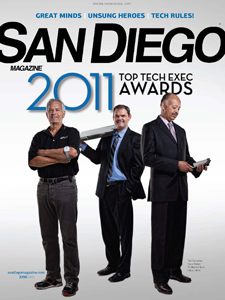Calit2 IT Manager wins 'Top Tech Exec' Award
By Tiffany Fox, (858) 246-0353, tfox@ucsd.edu
San Diego, Calif., May 24, 2011 — For Tad Reynales, manager of Technical Infrastructure at the UC San Diego division of the California Institute for Telecommunications and Information Technology (Calit2), being recognized as one of San Diego’s “Top Tech Execs” this month came a welcome surprise.
|
“Often, IT people are not acknowledged unless something goes wrong, like an outage or a security breach,” says Reynales. “I’m especially pleased to see the IT sector recognized as an important part of business and education in San Diego.”
Reynales was awarded the honor at a reception at the Del Mar Fairgrounds, beating out several other nominees in the “Education -- Small” category. Although UCSD is far from a “small” university, the technical infrastructure Reynales oversees at Calit2 is considered small by comparison.
The awards are sponsored by Cox Business and San Diego Magazine, which featured Reynales and two other “top execs” on the cover of a special promotional edition of its June publication. Emily Deere, executive director of IT Applications for Administrative Computing and Telecommunications at UCSD, was nominated in the “Education -- Large” category.
According to the accompanying feature in San Diego Magazine, the prizes are awarded to executives who “have the vision to innovate and take risks, all in the name of making their organizations more connected, more productive and more successful.”
Calit2 Divisional Director Ramesh Rao says he’s pleased to see Reynales earn county-wide recognition for his efforts, especially because people in his field tend to be “somewhat invisible regional resources.”
“As IT networks become more pervasive, it’s important to have at the helm people who know what the possibilities are,” adds Rao. “Tad’s experiences with a variety of complex, data-intensive projects give him a larger view about the impact that certain technologies can have and how to implement these technologies in concordance with operational policies. This is a rare quality.”
Reynales and his team provide infrastructure support for multiple interdisciplinary projects in Calit2’s four major research thrusts -- energy, environment, health and culture -- by helping scientists, engineers and clinicians manage the continuing explosion of data in these areas.
The resulting collaborations have harnessed everything from body monitoring technologies, wireless sensors, virtual reality visualizations and telemedicine, along with an increasingly sophisticated biomedical cyberinfrastructure to store, integrate, compute, visualize and model patterns of data important to health.
Adds Reynales: “Calit2’s mission is to explore new technologies, particularly telecommunications technologies, to enable applications that will improve economic opportunities and quality of life. In a larger sense, what we’re trying to do is match up resources to research needs, whether its compute, storage or network resources.”
An example of that synergy is reflected in Calit2’s GreenLight project, which is investigating the use of water-cooled shipping containers as systems to provide more energy efficient computing and data storage than conventional data centers can achieve, and which also can be deployed much faster than it takes to construct a building.
“A lot of what we do now is to try to create efficient designs to work with large datasets, such as those for bioinformatics and metagenomics research,” Reynales explains. “These projects have in common that they involve multiple terabytes of data, so almost every day we’re looking at some aspect of workflow support, storage or high-definition data visualization.”
Reynales’ 20 years of experience in supporting advanced network and computing infrastructure also earned him a spot on the technical advisory group for the California Telehealth Network, a statewide network that will connect both remote rural and underserved urban sites with technology-enhanced health services.
“The Telehealth Network has had a huge impact on people who have no hope,” notes Rao. “We’re talking about regions of California that have one doctor for a 100-square-mile region. These are places that are so impoverished in terms of technology and infrastructure that the IT support Tad and his colleagues provide are literally a lifeline.”
Reynales adds that he’s especially proud of the support he and his team have provided to the OptIPuter optical network, which allows researchers at UCSD and other universities to share large datasets at speeds of up to ten gigabits-per-second.
“My team supports the design, deployment and operation of these technologies, and part of that enabling process is to remove constraints. In particular we’ve tried to remove any network congestion so that researchers can perform experiments without being limited by networking,” he explains.
“For the same reason, we look to the San Diego Supercomputer Center for its large data storage and computing capacity. These resources are available in very few places. So in many respects, my contributions have been enabled by the facilities on this campus and all the talented people who work here.”
Media Contacts
Tiffany Fox, (858) 246-0353, tfox@ucsd.edu
Related Links


